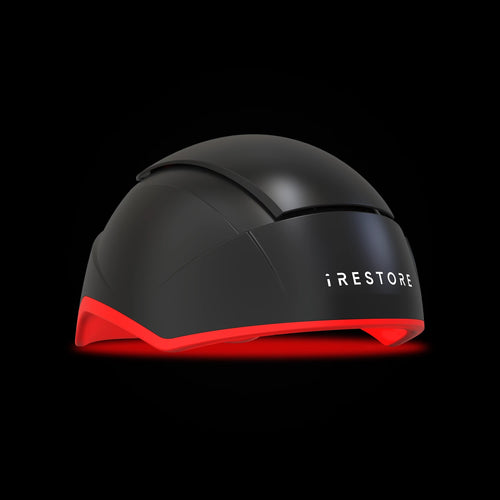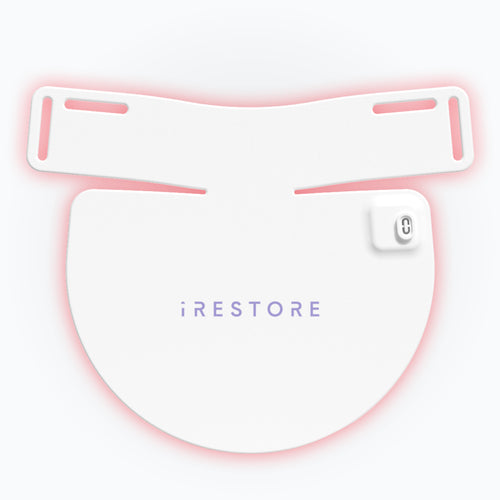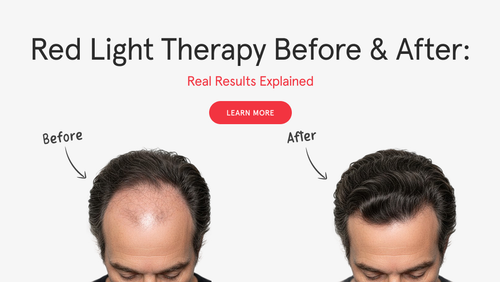Noticing that your hair has stopped growing can feel frustrating especially when you’re eating right, sleeping well, and using every product that promises results. According to a recent study by American Academy of Dermatology, nearly 40% of women and 30% of men experience visibly slowed hair growth at some point in their lives
This slowdown, often described as stunted hair growth, doesn’t always signal permanent hair loss. In most cases, it’s a sign that your hair follicles have entered a prolonged resting phase due to stress, scalp buildup, or nutrient imbalance. In this article, we’ll explore why hair growth stops, share how to restart hair growth naturally through proven scalp and lifestyle tips, and explain how red light therapy works to reactivate your hair’s natural growth.
What Causes Stunted Hair Growth?
If your hair seems to grow to a certain length and then stop, it’s often a sign that your follicles aren’t cycling as efficiently as they should. Each strand of hair goes through three main stages: anagen (growth), catagen (transition), and telogen (resting). When internal or external factors disrupt this cycle, your hair can spend more time resting than growing.
Let’s look at the most common causes dermatologists find:
1. Nutrient Deficiency and Hormonal Imbalance
Your hair needs consistent nourishment to grow. Deficiencies in iron, zinc, biotin, or vitamin D can weaken follicles, slowing the rate of cell renewal. In women, hormonal changes such as postpartum shifts or thyroid imbalances often trigger temporary growth stalls. (Source)
2. Scalp Health and Follicle Blockage
Product buildup, excess oil, and environmental pollutants can clog follicles and suffocate new growth. A healthy scalp allows oxygen and nutrients to reach the root, while an inflamed or congested scalp can slow follicle activity. (Source)
3. Stress and Lifestyle Factors
Chronic stress elevates cortisol levels, which can prematurely push hair into the resting phase. This condition, known as telogen effluvium, often causes noticeable thinning months after a stressful event.
4. Over-Styling and Heat Damage
Excessive heat styling, chemical treatments, or tight hairstyles can cause breakage that looks like slowed growth. When the ends keep breaking, your hair never appears to get longer, even though follicles are still active.
How to Fix Stunted Hair Growth Naturally?
Once you understand what’s slowing your hair down, the next step is to create the right environment for it to grow again. The good news? Most cases of slow hair growth can be improved with consistent scalp care, nutritional support, and healthy lifestyle changes.
1. Rebalance Your Scalp Microenvironment: Think of your scalp as the “soil” your hair grows from. When buildup, oil, or inflammation take over, new growth struggles to emerge.
-
Cleanse regularly with a sulfate-free shampoo to prevent residue and product film.
-
Exfoliate once a week using a mild scalp scrub or brush to remove dead skin and stimulate blood flow.
-
Massage your scalp for 3–5 minutes daily as it can increase circulation and support nutrient delivery to the follicles.
2. Nourish Follicles from Within: Your hair is built from the nutrients you eat. A deficiency in essential vitamins or protein directly affects how fast new strands grow.
Focus on foods rich in:
-
Biotin and Zinc – to support keratin production.
-
Iron and Vitamin D – for follicle oxygenation.
-
Omega-3 fatty acids – to maintain scalp hydration.
For a deeper dive, see our post on the best foods for strong, healthy hair.
3. Reduce Stress and Prioritize Rest: Stress silently interferes with your growth cycle. When cortisol levels stay high, more follicles shift into the resting phase.
Simple daily habits can make a measurable difference:
-
Practice deep breathing or yoga for 10 minutes a day.
-
Maintain a regular sleep schedule of 7–8 hours.
-
Stay hydrated as even mild dehydration can weaken hair fibers.
4. Protect Your Hair From Damage: Physical damage often leads to slow growth. Reduce heat exposure, limit chemical treatments, and switch to gentle detangling tools.
-
Avoid tight hairstyles that pull on roots.
-
Air dry when possible, or use a low-heat setting.
-
Use silk pillowcases to minimize friction overnight.
How Red Light Therapy Helps Restart Hair Growth?
While nutrition and scalp care set the foundation, sometimes your follicles need an extra boost to restart active growth. That’s where Low-Level Laser Therapy (LLLT), also known as red light therapy, comes in.
LLLT is a safe, non-invasive treatment that uses specific wavelengths of light to stimulate cellular activity inside hair follicles. This light energy helps increase blood circulation, deliver more oxygen and nutrients, and reactivate dormant follicles that have stopped producing new hair (Source). Each light wavelength penetrates the scalp to reach the base of the follicle, where it triggers the mitochondria of your cells. This process enhances ATP (Adenosine Triphosphate) production, giving follicles the fuel they need to restart the growth phase.
The iRESTORE Advantage
iRESTORE’s FDA-cleared red light therapy system delivers this proven technology in a form that’s safe and convenient for at-home use. It combines medical-grade lasers and LEDs that target thinning areas across the scalp to rejuvenate follicle activity.
What makes it effective:
-
Clinically validated results: In an independently reviewed study, participants using iRESTORE’s device experienced visible improvement in hair count and thickness after 16 weeks of regular use.
-
Safe and comfortable: iRESTORE is FDA-cleared, meaning it meets strict safety and performance standards for at-home hair restoration.
-
Consistency-based results: Most effective when used 3–6 months, 3–4 times a week for 25 minutes per session.
iRESTORE Hair Growth: Real Stories, Real Progress
When it comes to hair restoration, nothing speaks louder than real results. Across thousands of verified reviews, iRESTORE users consistently mention three things: visible improvement in thickness, less shedding, and renewed confidence after consistent use.
Here’s what members of our community are saying:

Conclusion
Slow hair growth can be frustrating, but it’s rarely permanent. By improving scalp health, nourishing your body, and using FDA-cleared red light therapy for hair growth, you can help your hair follicles return to their natural rhythm, safely and consistently.
Knowing when to act makes all the difference. Whether your hair has hit a plateau or you’re just starting your regrowth journey, iRESTORE helps you take charge with science-backed care you can trust.
Loved by over 500K+ customers worldwide, iRESTORE combines science and simplicity for real results right at home.
FAQs on Stunted Hair Growth
1. Why did my hair stop growing?
Hair can slow down when follicles spend too long in the resting phase. Stress, buildup on the scalp, or low nutrients are common triggers.
2. How do I fix stunted hair growth naturally?
Keep your scalp clean, exfoliated, and stimulated with gentle massage. Eat enough protein, iron, and biotin. Protect hair from heat and tight styles.
3. Does red light therapy really work for hair growth?
Yes. Low-Level Laser Therapy (LLLT) has been shown in clinical studies to increase hair count and thickness within 16 weeks when used consistently.
4. How long does iRESTORE take to show results?
Most users notice fuller-looking hair and less shedding in about 3–6 months of regular use. Staying consistent is essential.
5. Can I use iRESTORE with other hair growth treatments?
Yes. iRESTORE’s FDA-cleared red light therapy is non-invasive and can be used alongside topicals or supplements. Check with a dermatologist if you’re on prescription treatments.
Disclaimer: The iRESTORE blog is for informational purposes only and is not intended to replace professional medical advice or treatment. Please do not ignore professional guidance because of information you’ve read here. If you have concerns about your hair or skin health, we encourage you to consult a qualified healthcare professional.



















